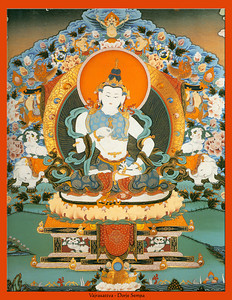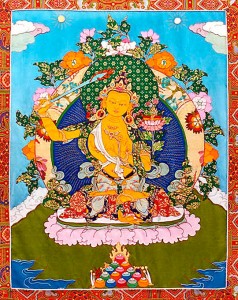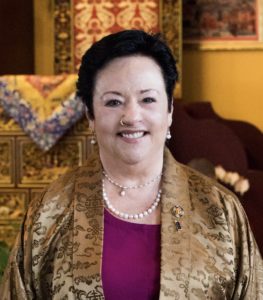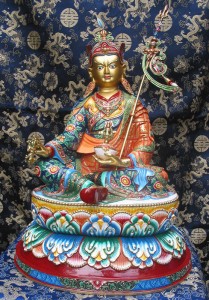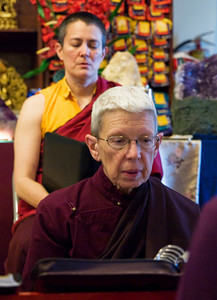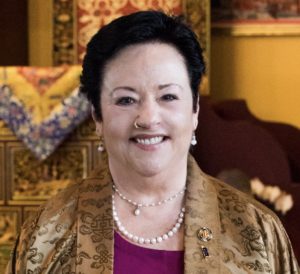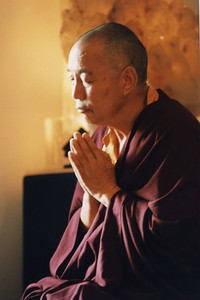
From The Spiritual Path: A Compilation of Teachings by Jetsunma Ahkon Lhamo
In Vajrayana Buddhism, the Teacher is the cornerstone of all practice. The Teacher is everything—the underlying strength and the means by which transmission and understanding occur.
Let us compare the Teacher’s function with the function of various other objects of refuge. All people—not just Buddhists—have such objects. Try for a moment to determine your own. If you think that the accumulation of material wealth is the way to happiness, money has become your guru. The material things you treasure are your guru. If, on the other hand, you choose the beer-and-sports routine, watching ESPN every night until you fall asleep, you have accepted the TV as your guru. It pacifies you. It makes you temporarily happy. You betray yourself: these things are unreliable, impermanent, and deceptive. Yet you put your trust and faith in them. Nothing in our impermanent realm of phenomenal existence can lead to happiness. Nothing—even if it seems ideal, like the perfect job or the perfect relationship in a perfect split-level, with 2.5 perfect children surrounded by a perfect white picket fence. At the moment of death, you are alone.
According to Buddhist teaching, there is a lasting happiness: enlightenment. It is the only end to all forms of suffering, including impermanence. Enlightenment cannot be tainted; it cannot be eaten by moths. It cannot rust; it cannot be destroyed. Enlightenment is the true source of refuge, the only thing that will not allow you to be betrayed. True happiness cannot be taken away. It is permanent and unchanging—the steadfast, stable reality of the enlightened mind. When you achieve enlightenment, what is revealed is your own primordial-wisdom nature. Some people think that they must give birth to enlightenment or that they have to find it. Actually, the primordial-wisdom nature has never left you, nor is it unborn. It remains in the way that a crystal is still a crystal, even though covered by dirt and mud.
Once you accept enlightenment as your goal, you should understand that the Guru is someone who can get you there. What should you look for in a Guru? A Teacher should not be seeking power or personal gain. Your Guru should have profound compassion, profound awareness. Most important, your Teacher should be able to transmit to you a true path. Suppose you go to a psychiatrist who helps you to be happier, more effective. This is very useful, but it is only a temporary way to cope, whereas the Guru offers you supreme enlightenment. This has nothing to do with coping. In fact, it has nothing to do with satisfying the ego.
Do not be fooled by charisma, saying: “I can tell by my feelings. This is the Teacher for me!” Instead, ask: Does this person teach a path that has been proven, time and time again, to stabilize the mind to the extent that miraculous activity can occur? Does this Teacher offer a technology that can stabilize the mind during the death experience? Can this technology result in miraculous signs at the time of passing? Are there indications that others have had success with this path and can now return in an emanation form in order to benefit beings? Look at the people who have practiced before you. Look at their successes or failures. Examine the history of the path, including the accounts of any enlightenment it has produced. At their passing, practitioners may produce miraculous signs: rainless rainbows, sweet scents, the transformation of the body into a rainbow of light, leaving only the hair and nails, the mysterious formation of relics or other unusual substances. On the Vajrayana path, such miraculous signs have been witnessed and recorded by many. People have seen the rainbow body; they have smelled the sweet scents; they have seen these extraordinary events.
The Buddha Himself said that we should use logic in choosing a Teacher or a path. After that, however, you begin to rely on the Teacher for everything. Why? Because you make a god out of your Teacher? Do you lose your brains and become a drone or a bliss ninny? Not at all. We Americans like to think we are unique, important, the best in the world. We think that to be happy, we must develop our individuality, so the idea of following a Guru is unappealing. But a teacher should not be chosen with blind faith or rampant emotion. You should exercise both intelligence and surrender. They are not in conflict. They can coexist very comfortably within the same mind, the same heart.
Note that you do not surrender to a person. It is not about a person. Your Teacher represents the door to liberation, the path that leads to enlightenment. Your relationship with the Guru is the most precious of all relationships. This is you talking to you—and finding out that you are not you at all. This is a glimpse, a taste, of true nature. At last we have arrived at the correct way to understand the Teacher.
Cultivate the precious relationship with your Guru through devotion. Make sure, however, that it really is devotion—not merely the kow-towing to a physical being. Devotion is an understanding of refuge, an understanding of your goal, plus the courage to walk through the door you have chosen. Choose only once, and choose correctly. From then on, allow yourself the grace to love deeply and gently.
© Jetsunma Ahkön Lhamo
